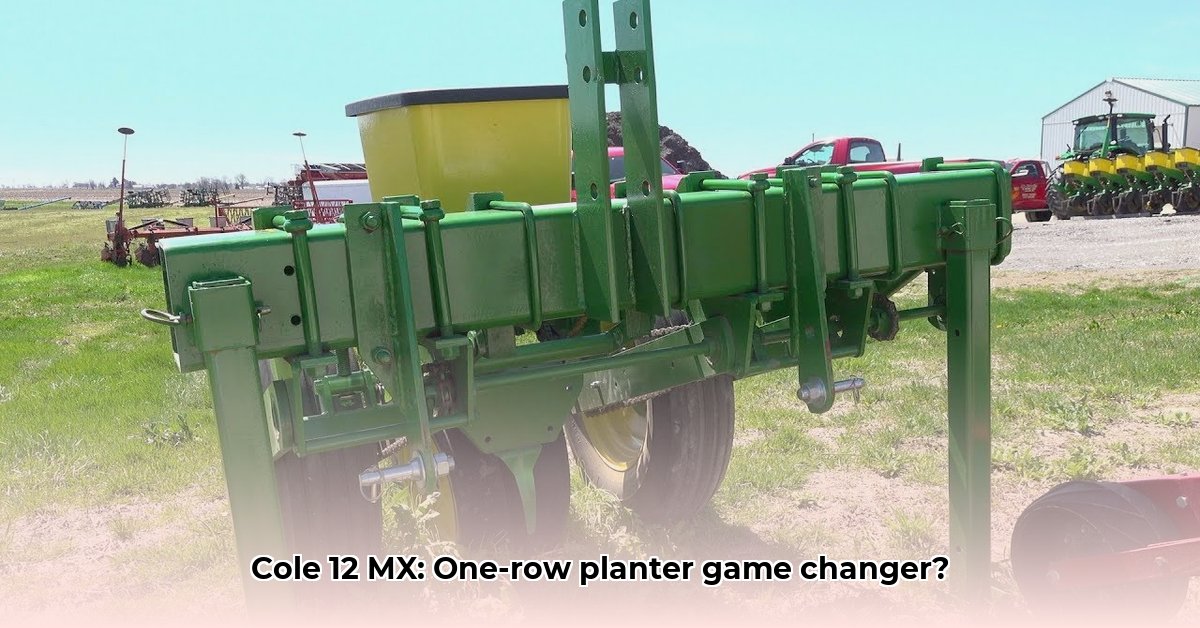
One-Row Planter Tractor: Cole 12 MX Deep Dive
This review assesses the Cole 12 MX one-row planter tractor, focusing on its performance, ease of use, and reported issues based on user feedback and available specifications. This analysis aims to inform potential buyers about its strengths and weaknesses, allowing for an informed purchasing decision. For more tractor insights, check out this helpful resource.
Planting Precision: A Detailed Look
The Cole 12 MX consistently demonstrates accurate seed placement and depth control, a crucial aspect for optimal germination. It handles diverse seed types, including corn, beans, peas, and smaller varieties, with precision fertilizer distribution ranging from 34 to 650 lbs per acre. The MultiFlex design ensures consistent depth across the field. The deep V seed opener receives praise for its gentle seed placement, minimizing damage. The gravity-drop hopper system provides a straightforward and effective seed delivery method.
However, some users report occasional clogging when the planter is lowered while stationary. This minor inconvenience is easily mitigated with proper technique. Is this minor drawback enough to outweigh the precision planting benefits? That depends on the individual farmer’s priorities.
User Experience and Cost Analysis
The Cole 12 MX's affordability is a significant draw for budget-conscious farmers. Its price point is lower than comparable models from larger manufacturers, representing a reduced upfront investment. One user reported significantly lower expenses compared to purchasing from a major dealer. But does this lower cost translate to compromises in quality or durability?
The planter’s design prioritizes ease of use, making it accessible to farmers who prefer simpler equipment. However, this simplicity might come at the cost of advanced features found in more expensive models. How important are these additional features to your farming operation?
Shipping and Customer Support: Addressing the Challenges
A significant concern revolves around shipping damage. Numerous users report receiving damaged planters, ranging from minor scratches to substantial structural issues. While some suppliers attribute this to pre-existing damage, the frequency of these reports highlights systemic issues with packaging, handling, and potentially, overall quality control. Does this suggest a need for improvements in the supply chain?
Customer service experiences are also reported as consistently frustrating. Many users describe difficulties in receiving timely and effective support, creating concerns about post-purchase assistance. Considering the vital nature of timely repairs and support for critical equipment, this issue significantly impacts the overall value proposition. How crucial is responsive and effective customer support to your operation?
Sustainability Considerations: A Balanced Perspective
The Cole 12 MX's precise planting contributes to sustainable practices by reducing seed and fertilizer waste. This efficiency minimizes environmental impact. However, the high incidence of shipping damage introduces a counterpoint. Repeated returns and replacements contribute to a higher carbon footprint, requiring improvements in packaging and handling to maintain a truly sustainable approach.
Weighing the Pros and Cons: A Final Assessment
The Cole 12 MX presents a complex picture. Its accurate planting and affordability are strong selling points. However, the substantial issues with shipping damage and customer support require careful consideration.
Pros:
- Precise planting.
- Versatile seed handling.
- Affordable price point.
- User-friendly operation.
Cons:
- Significant shipping damage reports.
- Poor customer service responsiveness.
- Potential for clogging (easily mitigated).
Making an Informed Decision: Key Recommendations
Before purchasing, consider:
- Thorough Inspection Upon Delivery: Meticulously inspect the planter for damage and document everything with photos and videos. Report any issues immediately.
- Proactive Communication: Maintain clear communication with the distributor and Cole Equipment regarding any issues. Keep detailed records of all interactions.
- Preventative Maintenance: Establish a regular maintenance schedule to prevent breakdowns and prolong the machine's lifespan.
- Total Cost Assessment: Factor in potential repair and replacement costs into your budget.
The decision of whether the Cole 12 MX meets your farm's needs requires careful weighing of its positive and negative aspects. The precision planting capabilities are appealing, but the risks related to shipping and support cannot be overlooked. Prioritize your needs and resources to make the best choice for your operation.
How to Minimize Cole 12 MX Planter Shipping Damage
Minimizing shipping damage requires a multi-pronged approach focusing on careful packaging, appropriate shipping containers, and proactive communication.
Packaging for Safe Transit: A Step-by-Step Guide
- Thorough Wrapping: Individually wrap all parts using bubble wrap, foam padding, and protective blankets. Pay close attention to delicate components and exposed mechanisms.
- Custom Crating (Recommended): Consider a custom-built crate for superior protection. Ensure sturdy materials and proper internal bracing.
- Secure Components: Use straps, restraints, and wedges to firmly secure all components within the crate, preventing movement during transit.
Shipping Container Strategies: Key Considerations
- Appropriate Container Selection: Choose a container sized and rated for the planter's dimensions and weight to prevent overcrowding and shifting.
- Proper Loading: Load and secure the planter correctly within the container using bracing and restraints to prevent shifting during transport.
- Shock Absorption: Consider incorporating additional shock-absorbing materials like air cushions or specialized pads within the shipping container.
Minimizing Risk: A Proactive Approach
- Pre-Shipping Inspection: Thoroughly inspect the planter before shipping, documenting pre-existing damage with photos and notes.
- Reputable Shipper Selection: Choose a freight carrier experienced in handling heavy agricultural equipment with a positive track record.
- Insurance Coverage: Obtain adequate shipping insurance to cover potential damage or loss.
This proactive approach significantly reduces the risk of shipping damage and protects your investment.